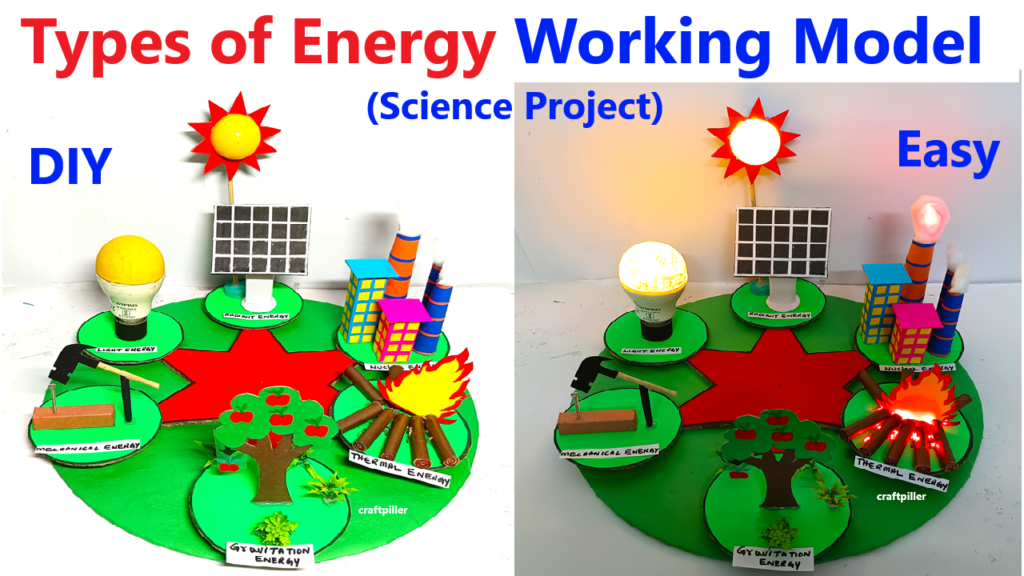Objective:
To create an interactive working model that demonstrates various types of energy (such as mechanical, electrical, chemical, light, and thermal energy) using LED lights, color paper, and cardboard to make the concept visually engaging and educational.

Materials Required:
- Cardboard (for the base, energy source, and structure)
- Color paper (for decorating each energy type and creating visual effects)
- LED lights (to represent energy types, such as light or electrical energy)
- Small motors (for mechanical energy demonstration)
- Wires, battery, and switches (for electrical energy circuit)
- Plastic bottles or containers (for creating chemical energy sections, such as a battery)
- Thermometer or paper thermometer (for demonstrating thermal energy)
- Scissors, glue, and tape (for assembling)
- Markers and labels (for clear identification of energy types)
Steps to Build the Model on Types of Energy :
- Prepare the Base:
- Cut a large piece of cardboard to serve as the base of the model. This will hold the different energy types and their visual representations.
- You can divide the base into sections, with each section representing a different type of energy.
- Demonstrating Electrical Energy:
- In one section, set up an LED light and wire it to a small battery (such as a 9V battery). This will show how electrical energy can power a light.
- Use color paper to label the section as “Electrical Energy” and provide a short explanation next to it.
- You can add a switch to control the LED light, showing how electrical circuits work.
- Demonstrating Mechanical Energy:
- In another section, use a small motor powered by a battery to rotate a fan or wheel, representing mechanical energy.
- Attach the motor to a cardboard wheel or fan blade, and when activated, the motor will spin the fan, demonstrating the conversion of electrical energy into mechanical energy.
- Label this section as “Mechanical Energy.”
- Demonstrating Chemical Energy:
- Use plastic bottles or small containers to simulate a chemical battery. You can create a simple model of a battery using zinc nails and copper wire to show how chemical reactions produce energy.
- Fill the container with a mixture of water and an electrolyte (like vinegar or lemon juice), and place electrodes inside. You can connect the resulting circuit to power a small LED light.
- Label this section as “Chemical Energy” and describe how chemical energy is stored and released through reactions.
- Demonstrating Thermal Energy:
- In a section representing thermal energy, you can create a simple heat source like a small light bulb or miniature heater powered by a battery. The light bulb will emit heat when turned on, demonstrating thermal energy.
- You can use color paper to show heat radiating from the bulb, such as by creating wavy lines around the light bulb.
- Use a thermometer to demonstrate how thermal energy affects temperature. You can place the thermometer near the heat source to show the temperature change.
- Label this section as “Thermal Energy.”
- Demonstrating Light Energy:
- In a section dedicated to light energy, use a solar-powered LED light or a simple LED to show how light energy is produced.
- You can create a small sun section by using yellow color paper to make the sun and show how light energy travels from the sun to Earth.
- Label this section as “Light Energy” and explain how light from the sun is a primary source of energy for Earth.
- Interactive Features:
- Use wires and switches to make the model interactive. Viewers can switch on or off each energy section to see how the energy works in action.
- Each section can light up or show movement when the corresponding energy is activated, helping viewers understand the concept of energy transformation.
- Final Assembly:
- Once all sections are assembled, make sure the wires are connected properly, and test each energy type to ensure the model works smoothly.
- Secure all parts in place using glue and tape.
- You can add arrows, labels, and markers to indicate the flow of energy and explain how energy transforms from one type to another.
How It Works:
- Electrical Energy:
- The battery powers the LED, showing how electrical energy can be converted into light energy.
- Mechanical Energy:
- The motor shows how electrical energy is converted into mechanical energy to make the fan or wheel rotate.
- Chemical Energy:
- The battery demonstrates how chemical reactions release energy in the form of electrical power, which can light up an LED.
- Thermal Energy:
- The heat source (light bulb or mini heater) shows how electrical energy is converted into thermal energy, causing an increase in temperature.
- Light Energy:
- The solar-powered LED or bulb demonstrates how light energy is emitted and can be harnessed from the sun.

